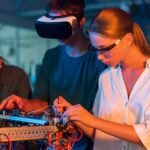Introduction
Regarding IT education, few names really speak to me as strongly as Anthony Hardy Legacy and Lanier Tech. Well-known for his innovative approach, Hardy has been instrumental in rethinking educational expectations using technology. Leading Lanier Technical College, he has supported projects aiming at not only modernizing educational opportunities but also equip students for the future employment. This article investigates the junction of technology and education, highlighting Hardy’s contributions to Lanier Tech as well as more general ramifications for tech education.
Background Study of Anthony Hardy Legacy and Lanier Tech
Anthony Hardy Legacy and Lanier Tech journey in transforming tech education began with his profound belief in the potential of technology to revolutionize learning. Hardy, having a solid grounding in both practical application and educational theory, saw early on the widening discrepancy between conventional educational approaches and the demands of contemporary businesses. Virtual reality, artificial intelligence, and cloud computing have been included into the course of his time at Lanier Technical College, therefore reflecting modern technology. Hardy has made sure Lanier Technology stays on top of educational innovation by building alliances with top tech businesses, thereby arming students with skills immediately relevant in tech-driven employment. These initiatives have improved Lanier Tech’s learning environment as well as established a standard for other colleges trying to close the distance between industry demands and education.
The Impact of Technology on Education
The foundation of social development has always been education; technology is transforming this field at before unheard-of speed. The days when learning came limited from textbooks and chalkboards are long gone. Digital technologies and platforms are improving worldwide educational delivery nowadays. This change is seen at Lanier Technical College as technology permeates all aspects of education including instruction.
Technology is removing obstacles to studying at many different educational institutions all over. Technology is democratizing education whether through AI-driven platforms that customize learning experiences or virtual classrooms linking students across countries. Lanier Tech is no different; it has embraced these developments to provide its students a strong and exciting education.
Technology integration at Anthony Hardy Legacy and Lanier Tech goes beyond following trends to include driving innovation. From providing classes on innovative tech advances to using state-of-the-art learning management systems, Lanier Tech shows how educational institutions may use technology to raise standards. These developments have made the institution a pioneer in tech education, drawing teachers as well as students ready to experience a contemporary classroom.
Anthony Hardy Vision for Lanier Tech
Anthony Hardy drives Lanier Tech’s technical development from its core. His ambitious and forward-looking strategy for incorporating technology into the infrastructure and course of study for the university is Hardy sees a college where all learning activities revolve around technology, enhancing the student experience and arming them with skills fit for the tech-driven environment of today.
Hardy underlines in his own words the need of technology in education, saying, “Incorporating technology isn’t just a choice; it’s a necessity for preparing students for the future.” This idea permeates his efforts at Lanier Tech. From adding new tech-oriented courses to modernizing university buildings with the newest technologies, Hardy’s initiatives guarantee that the institution stays leading edge in terms of educational innovation.
Looking ahead, Hardy’s ideas fit more general trends in computer education. In his vision, virtual reality improves experiential learning and artificial intelligence instructors offer real-time comments. Hardy is laying the conditions for Lanier Tech to keep flourishing in the rapidly changing field of tech education by matching its objectives with these new developments.
Key Features of the Anthony Hardy Legacy and Lanier Tech
Lanier Technical College has put various important initiatives under Anthony Hardy’s direction that show the connection between education and technology, therefore improving the learning environment. The classroom’s incorporation of virtual and augmented reality—which lets students participate in immersive, hands-on learning opportunities—is among the most noticeable changes. This method helps pupils understand and remember as well as gets them ready for practical use in several tech-centric sectors.
Strategic alliances with innovative technology businesses are also quite important. These partnerships have given students access to innovative tools and first-hand knowledge of business processes, therefore guaranteeing that they graduate with pertinent and practical skills. By helping to support the newest technologies, infrastructural improvements, and curriculum development, these alliances have also kept Lanier Tech leading edge innovative.
Furthermore defining Hardy’s legacy at Lanier Tech is his dedication to individualized technological instruction. By customizing instructional experiences to fit certain learning styles and requirements, the college’s usage of AI-driven platforms has helped to maximize student engagement and success rates. This customized approach is evidence of Hardy’s vision of using technology not just as an instructional tool but also as a method to develop every student’s potential.
Hardy has developed a sustainable model for IT education that fits the needs of contemporary businesses by including these elements into Lanier IT’s fabric, therefore establishing a benchmark for colleges all around. Lanier Tech often delivers graduates from these programs who are not just technically competent but also effective at negotiating and helping to shape a fast changing technology scene.
Success Stories and Case Studies
The many success stories that Anthony Hardy Legacy and Lanier Tech is producing clearly reflect Hardy’s goal. The Student Innovation Project, where a group of students created a smartphone app meant to streamline university navigation, is one very notable effort. This initiative emphasized not only their technical ability but also the college’s tools and support of student-led innovation.
Lanier IT’s affiliation with a nearby IT business is another evidence of their dedication to remain industry-relevant. This cooperation resulted in the creation of a new curriculum designed to satisfy present industrial demands, therefore guaranteeing that graduates have the skills and knowledge needed in the employment scene of today.
The narrative of an alumnus starting a profitable tech company following graduation further highlights the influence of the education. Equipped with the knowledge and abilities acquired at Lanier Tech, this person has made a major contribution to the tech world, therefore highlighting the institution’s influence in producing next industry leaders.
Expert Insights
When talking about IT education, Anthony Hardy emphasizes frequently the requirement of flexibility in instructional strategies. Many of Lanier computer’s faculty members share his belief that “education should mirror the dynamism of the tech industry.” Together with professionals in tech education, these teachers stress the need of lifelong learning and keeping current with technology changes.
Their observations highlight the need of practical knowledge in verifying the influence of technology in the classroom. Lanier Tech makes sure that students not only grasp theoretical ideas but also apply them in real-world situations by including hands-on projects and practical applications inside the course, therefore strengthening their preparation for the workforce.
Future of Tech Education at Lanier Tech
With various fascinating advancements on the horizon, Lanier Tech’s tech education has bright future. The university is looking at joint ventures with top IT businesses to provide students chances for internships, therefore giving them priceless industry exposure even before they graduate.
New initiatives emphasizing developing technologies such artificial intelligence, cybersecurity, and data analytics also are under development. These projects should improve the tech products of the university and confirm its leadership in tech education.
Plans to increase Lanier Tech’s virtual learning skills also clearly show its dedication to creativity. Building on the success of its move to online learning during the COVID-19 epidemic, the college wants to create hybrid learning models combining the best of both physical and virtual classrooms.
Challenges of the Anthony Hardy Legacy and Lanier Tech
Although Anthony Hardy’s direction at Lanier Technical College has produced many achievements and ideas, the road to leadership in tech education has not been easy. The fast speed of technology development itself is a major obstacle as it requires ongoing curriculum and teaching approach adaptation. To guarantee faculty and infrastructure match industry developments, this calls for significant financial resources as well as professional development commitment.
Moreover, keeping relationships with top technology businesses is a constant work. Although these partnerships are vital for giving students real-world knowledge and chances, they also call for cautious management and ongoing industry alignment with demands. Ensuring that curricular relevancy does not overwhelm educational integrity depends on juggling these relationships with academic aims.
Additionally, as Lanier Tech embraces more personalized education through technology, there is the challenge of ensuring data privacy and security. With increasing reliance on AI-driven platforms, the institution must implement robust measures to protect students’ personal and academic information against potential breaches.
Finally, while expanding access to virtual and augmented reality in classrooms is a goal, achieving equitable access for all students can be difficult. Providing the necessary technology to rural or underfunded areas, where students might lack internet access or devices, remains a priority but also a significant hurdle. Addressing these disparities is integral to fulfilling Lanier Tech’s mission of offering inclusive and transformative educational experiences.
Despite these challenges, the institution remains committed to overcoming obstacles and solidifying its position as a frontrunner in tech education under Hardy’s enduring vision.
Challenges Solutions: Step-by-Step Guides
Addressing the challenges associated with Anthony Hardy’s legacy and Lanier Tech’s growth requires strategic solutions through well-defined steps. Below are the comprehensive guides to tackle these obstacles effectively:
1. Keeping Curriculum Current
- Step 1: Establish an Industry Advisory Board
Ask executives in the IT sector to create a board that routinely checks curriculum materials to make sure courses fit future demands and present trends.
- Step 2: Ongoing Staff Development for Faculty
Implement a program for ongoing training and certifications for instructors in emerging technologies and teaching methodologies.
- Step 3: Integrate Feedback Loops
To find skill shortages and change the program, routinely get comments from companies and former students.
2. Strengthening Industry Partnerships
- Step 1: Regular Partnership Evaluations
Review semi-annually with industry partners to match expectations and goals, therefore guaranteeing mutually positive partnerships.
- Step 2: Collaborative Project Opportunities
Create collaborative initiatives and internships that provide students practical knowledge and associates with creative ideas.
- Step 3: Networking Events and Workshops
Organize regular gatherings to strengthen links and spot fresh joint projects with academics, staff, and business leaders.
3. Ensuring Data Privacy and Security
- Step 1: Implement a Comprehensive Security Policy
Create and implement rules covering data security, incident response procedures, and regulatory compliance.
- Step 2: Regular Audits and Assessments
Frequent risk analyses and security audits help to find any data system weaknesses..
- Step 3: Student and Staff Training
To protect institutional and personal data, staff and students should get mandated instruction on privacy policies and cybersecurity knowledge.
4. Ensuring Fair Access to Technology
- Step 1: Build Infrastructure Partnerships
Engage with technology companies and local governments to expand internet access and technology infrastructure in underserved areas.
- Step 2: Equip with Loaner Devices
Set up a scheme to give students without personal devices loaner computers and mobile hotspots.
- Step 3: Develop Community Tech Centers
Create satellite tech hubs with high-speed internet and learning resources in rural and underserved communities.
By implementing these strategies, Lanier Tech can continue to lead the way in tech education, successfully navigating the complexities of modern challenges while honoring the legacy left by Anthony Hardy.
Conclusion
Anthony Hardy Legacy and Lanier Tech journey is one of technological progress. Their efforts highlight the important part technology plays in contemporary education and provide a model for other colleges trying to include it into their courses. Hardy and Lanier Tech are not only educating kids for the future but also helping to shape the direction of education itself by supporting creativity and flexibility.
Engaging with Lanier Tech is a special chance for individuals who want to investigate the possibilities of tech education further to see personally the influence of visionary leadership and contemporary inventions. Whether your job is student, teacher, or industry expert, this creative university provides lots of knowledge to acquire and use.
FAQs about Anthony Hardy Legacy and Lanier Tech
What makes Anthony Hardy’s leadership at Lanier Tech stand out?
Anthony Hardy’s leadership is known for its emphasis on incorporating innovative technologies into the syllabus and developing close relationships with top IT businesses. Lanier Tech has been directed in giving creative tech education top priority in order to equip students for demands of the future business.
How does Lanier Tech ensure that its curriculum remains relevant to industry needs?
Establishing an Industry Advisory Board, ongoing faculty development, and including alumni and company feedback loops within Lanier Tech’s multi-step strategy help to This guarantees that courses follow industry standards and present technical developments.
What steps has Lanier Tech taken to protect student data privacy and security?
Lanier Tech has developed thorough security policies, does frequent audits and assessments, and offers staff and student required cybersecurity instruction in order to handle data privacy and security.
How does the institution address the challenge of equitable access to technology?
Building infrastructural alliances, arming students with loaner gadgets, and establishing community tech centers in underprivileged communities helps Lanier Tech ensure that every student has the tools they need for their education, therefore facilitating fair access.
In what ways can industry professionals engage with Lanier Tech?
Through cooperative project possibilities, networking events and seminars, and Industry Advisory Board membership, industry experts may interact with Lanier Tech to help to shape curricula and student mentoring.
What opportunities are available for students at Lanier Tech to gain real-world experience?
Through cooperative projects with industry partners, internships, and attendance in events that link students with experts and developing technologies, students may get practical experience thereby strengthening their readiness for tech sector professions.
How does Lanier Tech plan to expand its use of virtual and augmented reality in education?
Lanier Tech wants to increase the use of virtual and augmented reality by granting access to these technologies throughout classes, especially in disciplines where immersive learning may greatly improve student involvement and memory of difficult ideas.


